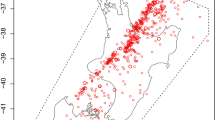Abstract
Earthquake swarms occur in many regions of the world. The study of earthquake swarms is very limited, and most contributions are descriptive. In this paper we propose use of a hidden Markov model to estimate the distribution of waiting times for swarm earthquakes and apply this approach to the largest earthquake swarm in the history of the Yellowstone area. Hidden Markov modeling is superior to modeling using either single distributions or finite mixture distributions because of the heterogeneity of data and temporal dependencies in earthquake sequences.








Similar content being viewed by others
References
Altman, R.M. (2004), Assessing the goodness-of-fit of hidden Markov models. Biometrics, 60, 444–450.
Baum, L.E., Petrie, T., Soules, G., and Weiss, N. (1970), A maximization technique occurring in the statistical analysis of probabilistic functions of Markov chains, Ann. Math. Statist., 41(1), 164–171.
Bilmes, J.A. (1998), A gentle tutorial on the EM algorithm and its application to parameter estimation for Gaussian mixture and hidden Markov models. ICSI-TR-97-021.
Burnham, K.P., and D.R.Anderson (1998), Model selection and inference-a practical information-theoretic approach. Springer-Verlag, New York.
Dempster, A.P.; Laird, N.M.; Rubin, D.B. (1977), Maximum likelihood from incomplete data via the EM algorithm. Journal of the Royal Statistical Society. Series B (Methodological), 39(1), 1–38.
Ebel, J.E., Chambers, D.W., Kafka, A.L., Baglivo, J.A. (2007), Non-Poisson earthquake clustering and the hidden Markov model as bases for earthquake forecasting in California, Seismological Research Letters, 78(1), 57–65.
Elliott, R.J., Aggoun, L. and Moore, J.B. (1995), Hidden Markov Models: Estimation and Control. Springer-Verlag, New York.
Forney, G.D. (1973), The Viterbi algorithm. Proceedings of the IEEE, 61(3), 268–278.
Fredkin, D.R. and Rice, J.A. (1992), Maximum likelihood estimation and identification directly from single-channel recordings. Proceedings of the Royal Society of London Series B 249, 125–132.
German, V.I. (2006), Analysis of temporal structures of seismic events on different scale levels. Pure Appl. Geophys., 163, 2243–2258.
Granat, R.A. and Donnellan, A. (2002), A hidden Markov model based tool for geophysical data exploration. Pure and applied geophysics, 159(10), 2271–2283.
Hainzl, S. and Ogata, Y. (2005), Detecting fluid signals in seismicity data through statistical earthquake modeling. J. Geophys. Res., 110 (B5): Art. No. B05S07.
Hainzl, S. and Fischer, T. (2002), Indications for a successively triggered rupture growth underlying the 2000 earthquake swarm in Vogtland/NW Bohemia. Journal of Geophysical Research, 107(B12), 2338.
Harte, D. (2006), Mathematical background notes for package “HiddenMarkov”. Statistics Research Associates, Wellington. URL: http://homepages.paradise.net.nz/david.harte/SSLib/Manuals/notes.pdf
Helmstetter A, Kagan Y.Y., and Jackson, D.D. (2006), Comparison of short-term and time-independent earthquake forecast models for Southern California. Bull Seismol Soc Am, 96(1), 90–106.
Houseman, E.A., Coull, B.A., and Ryan, L.M. (2006), A functional-based distribution diagnostic for a linear model with correlated outcomes. Biometrika, 93(4), 911–926.
Leroux, B.G. and Puterman, M.L. (1992), Maximum-penalized-likelihood estimation for independent and Markov-dependent mixture models. Biometrics 48, 545–558.
McLachlan, G. and Krishman, T. (1997), The EM algorithm and extensions. New York, Wiley.
McLachlan, G. and Peel, D. (2000), Finite Mixture Models. Wiley Series in Probability and Statistics.
Navidi, W. (1997), A graphical illustration of the EM algorithm. The American Statistician, 51(1), 29–31.
Petrushin, V. (2000), Hidden Markov models: fundamentals and applications (Part 1, 2). Online Symposium for Electronics Engineer 2000.
Pievatolo, A. and Rotondi, R. (2008), Statistical identification of seismicity phases. Geophysical Journal International, 173(3), 942–957, doi:10.1111/j.1365-246X.2008.03773.
Rabiner, L.R. and Juang, B.H. (1986), An introduction to hidden Markov models. IEEE ASSP Magazine, 3(1), 4–16.
Rabiner, L.R. (1989), A tutorial to on hidden Markov models and selected applications in speech recognition. Proc. IEEE, 77(2), 257–286
Ryden, T., Terasvirta, T., and Asbrink, S. (1998), Stylized facts of daily return series and the hidden Markov model of absolute returns. Journal of Applied Econometrics, 13, 217–244.
Sánchez, R., Newman, D.E. and Carreras, B.A. (2002), Waiting-Time Statistics of Self-Organized-Criticality Systems, Physical Review Letters, 88(6)(068302. doi:10.1103/PhysRevLett.88.068302
Talbi, A. and Yamazaki, F. (2009), A mixed model for earthquake interevent times. Journal of Seismology, doi:10.1007/s10950-009-9166-y
Touati, S., Naylor, M. and Main, G. (2009), Origin and nonuniversality of the earthquake interevent time distribution. Physical Review Letters, 102, 168501, doi:10.1103/PhysRevLett.102.168501
Waite, G.P. and Smith, R.B. (2002), Seismic evidence for fluid migration accompanying subsidence of the Yellowstone caldera. Journal of Geophysical Research, 107, NO.B9, 2177.
Weichert, D.H. (1980) Estimation of the earthquake recurrence parameters for unequal observation periods for different magnitudes. Bull Seismol Soc Am, 70(4), 1337–1346.
Yakovlev, G., Turcotte, D.L., Rundle, J.B. and Rundle, P.B. (2006), Simulation-based distributions of earthquake recurrence times on the San Andreas fault system. Bulletin of the Seismological Society of America, 96(6), 1995–2007.
Zucchini, W. and MacDonald, I.L.(1997), Hidden Markov and Other Models for Discrete-valued Time Series. Chapman & Hall.
Acknowledgments
We thank R.B. Smith for providing the data and R.M. Altman for help in goodness-of-fit tests. Discussion with G. Waite helped improve the manuscript. We also thank three anonymous reviewers, whose comments substantively improved the paper.
Author information
Authors and Affiliations
Corresponding author
Rights and permissions
About this article
Cite this article
Li, Y., Anderson-Sprecher, R. Hidden Markov Modeling of Waiting Times in the 1985 Yellowstone Earthquake Swarm. Pure Appl. Geophys. 170, 785–795 (2013). https://doi.org/10.1007/s00024-011-0323-1
Received:
Revised:
Accepted:
Published:
Issue Date:
DOI: https://doi.org/10.1007/s00024-011-0323-1




